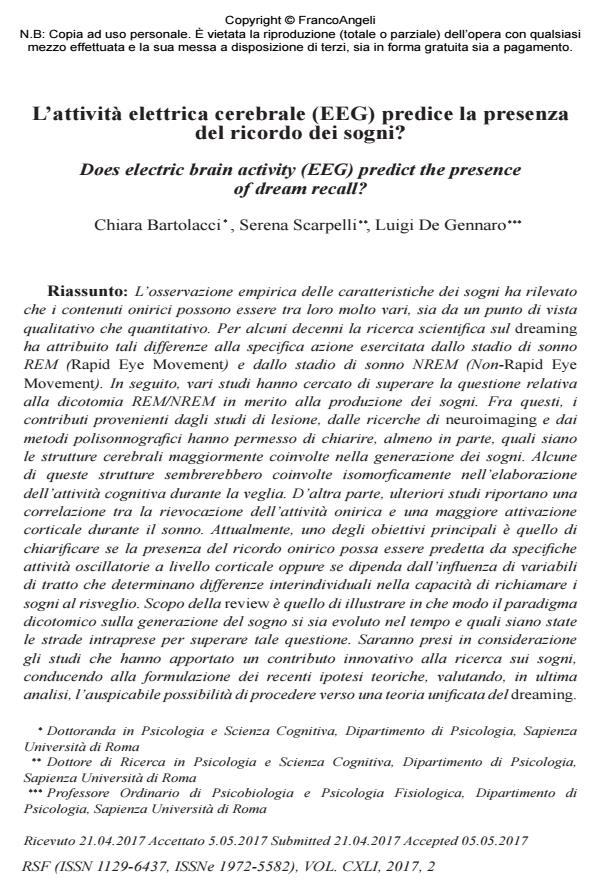L’attività elettrica cerebrale (EEG) predice la presenza del ricordo dei sogni?
Titolo Rivista RIVISTA SPERIMENTALE DI FRENIATRIA
Autori/Curatori Chiara Bartolacci, Serena Scarpelli, Luigi De Gennaro
Anno di pubblicazione 2017 Fascicolo 2017/2
Lingua Italiano Numero pagine 21 P. 79-99 Dimensione file 1816 KB
DOI 10.3280/RSF2017-002005
Il DOI è il codice a barre della proprietà intellettuale: per saperne di più
clicca qui
Qui sotto puoi vedere in anteprima la prima pagina di questo articolo.
Se questo articolo ti interessa, lo puoi acquistare (e scaricare in formato pdf) seguendo le facili indicazioni per acquistare il download credit. Acquista Download Credits per scaricare questo Articolo in formato PDF

FrancoAngeli è membro della Publishers International Linking Association, Inc (PILA)associazione indipendente e non profit per facilitare (attraverso i servizi tecnologici implementati da CrossRef.org) l’accesso degli studiosi ai contenuti digitali nelle pubblicazioni professionali e scientifiche
L’osservazione empirica delle caratteristiche dei sogni ha rilevato che i contenuti onirici possono essere tra loro molto vari, sia da un punto di vista qualitativo che quantitativo. Per alcuni decenni la ricerca scientifica sul dreaming ha attribuito tali differenze alla specifica azione esercitata dallo stadio di sonno REM (Rapid Eye Movement) e dallo stadio di sonno NREM (Non-Rapid Eye Movement). In seguito, vari studi hanno cercato di superare la questione relativa alla dicotomia REM/NREM in merito alla produzione dei sogni. Fra questi, i contributi provenienti dagli studi di lesione, dalle ricerche di neuroimaging e dai metodi polisonnografici hanno permesso di chiarire, almeno in parte, quali siano le strutture cerebrali maggiormente coinvolte nella generazione dei sogni. Alcune di queste strutture sembrerebbero coinvolte isomorficamente nell’elaborazione dell’attività cognitiva durante la veglia. D’altra parte, ulteriori studi riportano una correlazione tra la rievocazione dell’attività onirica e una maggiore attivazione corticale durante il sonno. Attualmente, uno degli obiettivi principali è quello di chiarificare se la presenza del ricordo onirico possa essere predetta da specifiche attività oscillatorie a livello corticale oppure se dipenda dall’influenza di variabili di tratto che determinano differenze interindividuali nella capacità di richiamare i sogni al risveglio. Scopo della review è quello di illustrare in che modo il paradigma dicotomico sulla generazione del sogno si sia evoluto nel tempo e quali siano state le strade intraprese per superare tale questione. Saranno presi in considerazione gli studi che hanno apportato un contributo innovativo alla ricerca sui sogni, conducendo alla formulazione dei recenti ipotesi teoriche, valutando, in ultima analisi, l’auspicabile possibilità di procedere verso una teoria unificata del dreaming.
Parole chiave:Ricordo onirico, dreaming, attivazione, ipotesi di stato, ipotesi di tratto, sonno.
Chiara Bartolacci, Serena Scarpelli, Luigi De Gennaro, L’attività elettrica cerebrale (EEG) predice la presenza del ricordo dei sogni? in "RIVISTA SPERIMENTALE DI FRENIATRIA" 2/2017, pp 79-99, DOI: 10.3280/RSF2017-002005